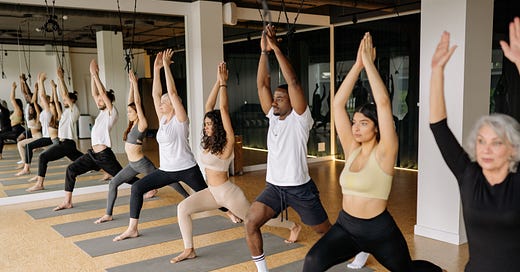General Yoga No Longer by NICE
I learnt recently that NICE (the National Institute for Clinical Excellence, in the UK) is no longer advising that doctors should recommend yoga to people with back pain. This is very disappointing for those of us in the yoga therapy world who frequently see students alleviate their back pain, through their regular, appropriate yoga practice. There’s also a growing body of scientific research to show that yoga can be an excellent non-invasive way of relieving back pain. However, the NICE decision is also unsurprising.
Specialist Yoga is Needed For Back Pain
There is a huge diversity of styles of yoga many of which involve fairly swift movement from one posture to another. This flowing style is a wonderfully uplifting, strengthening practice, which helps regulate mood and increase flexibility. This type of practice is marvellous if you have no back or joint pain. Our bodies are adaptable and love to move! Yoga provides a diversity of movement that very few other pastimes can offer. With the added health benefits of breath, relaxation, focusing and meditation practices it’s clear why yoga is so popular these days. However, for a person with chronic back or joint pain, repeated practice of some yoga postures can be challenging or even harmful.
Maybe It’s Good… Maybe Not…
Most people, even those who have a mild grumbly back due to sitting at a desk all day, might be very well served by a general yoga practice. Yet for others, it could exacerbate pressure on an intervertebral disc or weaken the sacroiliac ligaments and cause a back pain episode. Those with other back conditions such as arthritis or misaligned discs could also run into problems in a standard class. Given that the NICE guidelines didn’t recommend a specific type of yoga as being helpful for back pain, it’s no wonder they withdrew their recommendation.
Slower Yoga Not Necessarily Better for Backs
Even the slower more detailed yoga styles can add to stress for the spine and back. Yoga in the west has developed from around twelve lineages, all but one of which were headed by male gurus from India, where yoga is thought to have originated. These men had very different body types, lifestyles, mindsets and challenges compared to the average woman who turns up for a yoga class today. Without wishing to belittle the huge contributions of these men to yoga in general, basing all our ideas of correct alignment on their teaching, is unwise in my humble opinion. The physical practice of yoga has always been in the process of evolution and change. Now, it’s influenced by biomechanics, physiotherapy, somatics and other disciplines. As the majority of the asanas themselves were born out of a collaboration between yoga gurus, wrestlers and fitness experts in the 1930s we should not be alarmed by developing the physical practice of yoga. Indeed, it is appropriate that the asanas evolve and change as our understanding of anatomy changes.
Complex Yoga for Complex Humans
Poor alignment cues are not the only reason why teaching “correct alignment” is so challenging for yoga teachers. The main issue is complexity. The postures themselves are complex (unlike most floor-based Pilates exercises). Yoga postures work on the body as a whole, not just one part of it. Added to this, the human skeletal structure is also incredibly complex. Each human being in the class will have a slightly different articulation of the bones in their feet, ankles, knees, pelvis and spine. What is correct alignment for one person, will feel very uncomfortable or even unattainable to another. As such there are no hard and fast rules, there is no “one size fits all”.
First - Understand Your Back
As you can imagine, explaining the nuances of individualised anatomical alignment whilst students are moving through vinyasa at a fast pace to loud music is quite a challenge. Most yoga teachers do an excellent job in serving their students. However, no yoga teacher can know what it feels like in a student’s body. Indeed, it is not up to the yoga teacher to take responsibility for the student’s movement. So, if you have back pain that is not improving or getting worse, it’s best not to go to a general class until you really understand your own back. Understand what will relieve the stress in the areas that are painful and understand what will add to the stress. If you are pushing into a part of the spine that is already under stress, there is the potential that one day, something will give.
If you’re a regular yoga practitioner with back pain, who wishes to continue, it’s worth considering doing some extra study with a teacher who understands the spine and the muscles that support it. In this way, you can learn to make some changes to your practice to better serve your back health. Remember everyone is different, so finding out about your individual posture and spine is key.
Common Yoga Cues to Ignore If You Have Back Pain
If you can’t find such a teacher in your area, here are some thoughts about common yoga cues and how they might affect someone with back pain. Experiment with your own practice at home and see what feels better for you: the old school yoga way, or the spine friendly way. Let your body - not your mind - be your guide. Getting out of our “yoga habits” can offload the stress we can put on the spine, the effect can be a relief of back pain and a more enjoyable practice.
1. Old School Yoga Cue: Square the Hips (In one leg forward poses like Warrior I)Spine Friendly Cue: Don’t Square the Hips Allow the pelvis to rotate slightly towards the back leg. You can square your ribcage to the front edge of your mat and leave the pelvis to find its own place. However, no need to push the rotation to be absolutely square. If it feels uncomfortable, shorten your stride.
Rationale: The ribcage part of the spine is designed to rotate in opposition to the pelvis (e.g. when we walk). Squaring the pelvis with one leg behind us causes stress for the sacroilliac joints.
2. Old School Yoga Cue: Keep the Buttock Muscles Relaxed in Bridge PoseSpine Friendly Cue: Engage Your Buttock Muscles in Bridge
Rationale: This is what the glute maximus muscles are for. We really need this action in Bridge Pose to counteract the effects of sitting. Using your butt muscles equally and evenly will balance your sacroiliac joints and support the health of your knees and lower back. If your lower back feels tight when you squeeze your butt muscles, lower your hips a little and work on activating the lower part of the buttock muscles, near your sit bones.
3. Old School Yoga Cue: Feet Together (for Tadasana, Standing Mountain Pose)Spine Friendly Cue: Don’t have your feet together have them hip-width apart. Think of your hips as being at the top of your thigh bones in the hip socket and align your ankles with your hips, or wider.
Rationale: This cue was invented to make life easier for yoga instructors! When the feet are together we can’t turn our feet in or out. It’s fine to turn your feet slightly in or out if that is more comfortable for you. A feet together stance creates a small base of support and this causes gripping in the legs and buttock muscles, which can exacerbate back pain.
Movement Myth Busting
There are so many more of these corrections to old school yoga cues. I’ve focussed on some that affect the sacroilliac joints (which is one of the more common yoga lower back injuries). Such cues are not only to be found in the yoga world: the fitness world is also guilty of movement cues that don’t make sense. For a fantastic investigation into this erroneous cueing see my teacher Gary Ward’s book What the Foot? He blows all the movement myths apart and offers a great exploration of the anatomy of the moving body in his Anatomy in Motion courses. Here is a podcast of Gary talking to Dr Rangan Chatterjee (for anatomy nerds only!)
Movement is so important for our body, we need it for our mental and physical health. If you have back pain, and cannot access a yoga teacher who specialises in back pain then use this simple rule of thumb:
If it hurts, tweaks or twinges in your back or near a joint, don’t do it, or find a new expression of the pose that works for you.
If you’re feeling a challenging strengthening feeling in the belly of your muscles that’s fine!!
Enjoy your practice!!!
I’m interested to know, what’s your experience of practiting yoga with back pain. Does it help? Do you alter some of the postures to suit you?
Dear Yoga Student,
Hope you’re enjoying the sunshine!!
Last Call for the Yoga for Back Care Course
This week I’m launching the Yoga for Back Care Course. The first class is this Wednesday 11th May then it’s 12 classes (6 in-person / 6 online) from 6:30 - 8pm every Wednesday. There will also be homework practice to access online in between classes. I’m so looking forward to helping people relieve their back pain once again! Really, helping people find some pain relief is what makes my work as a yoga teacher so rewarding and so fascinating.
I’m keeping this course at the same price I offered it for in 2018, although there is more content. £265 per person.
If you’d like to join the course, there are still some places left. Find out more and you can also book here.
Empower Your Spine - Workshops at One Yoga
For those of you who have a regular yoga practice, but suffer from occasional or low level back ache, I’m doing a series of three workshops at the lovely One Yoga studio in Hornsey, North London. We’ll look at ways we can make a regular yoga practice more spine friendly, and we’ll of course be looking at individual spines to see what specific needs students have.
£25 per 2-hour workshop.
The workshops run on Saturdays 2:30 - 4:40pm on 14th May; 11th June; 9th July
To book these workshops go to the One Yoga website here.
All classes running as usual this week. If you’d like to book an in-person or Zoom class. Click the button below to go to the timetable.
With love and good wishes,
Julia xx













Share this post